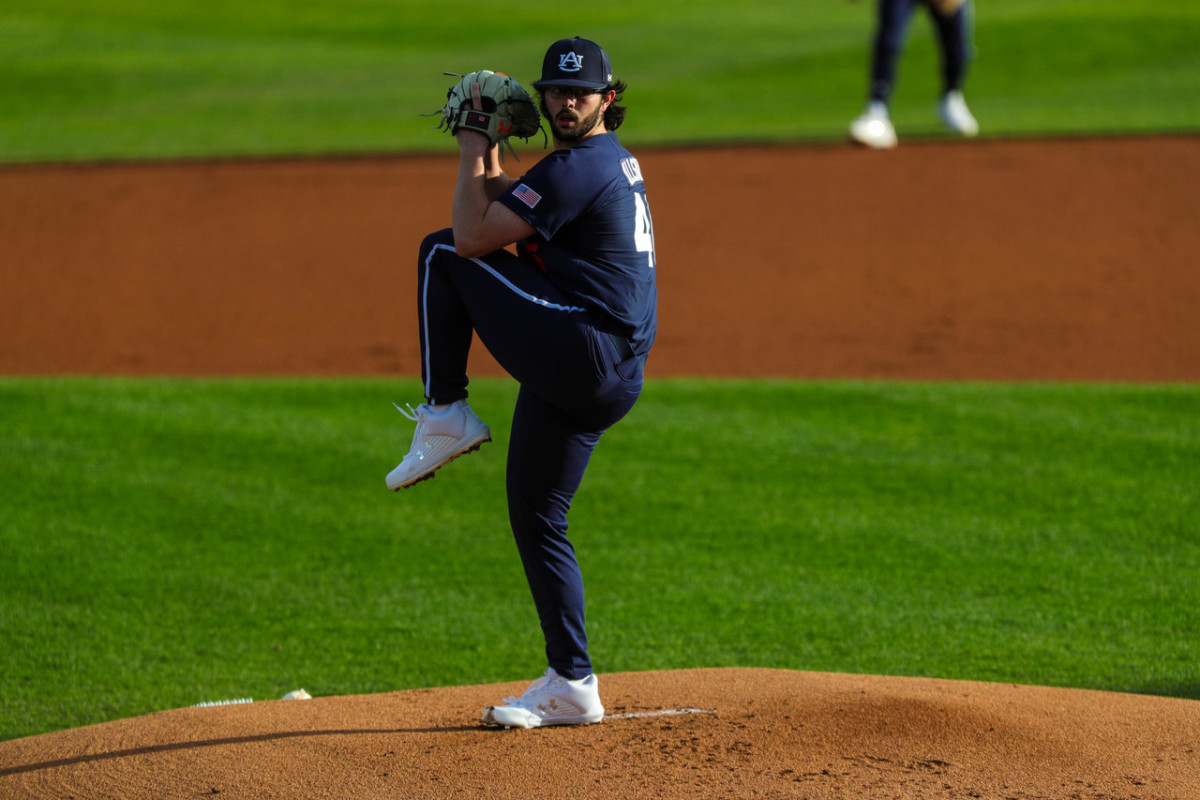Chase Allsup has the tools to be a dominant starter for Auburn baseball

Chase Allsup, physically, might be one of the more impressive pitchers Auburn's had on The Plains in a while.
With a fastball that can touch 97, effective breaking pitch options in the slider and curveball, and the makings of a changeup, Allsup's not hurting for options to throw. And with a 6'1, 240 frame, he's got the physical frame to carry that velocity deep into a start.
Now it's a matter of putting it all together.
After an abbreviated outing on Opening Day, where Allsup went two innings against Indiana with three hits, two runs, two walks, and four strikeouts on 48 pitches, there's some more work to be done against Southern California this Friday.

"We want to see Allsup again, see if he can get deeper into a ballgame. Be more efficient," remarked head coach Butch Thompson on Thursday, previewing the weekend matchup for the media.
Auburn Daily went back and watched every at-bat of Allsup's start against Indiana; here's what we noticed.
The first inning was two strikeouts, a walk, and a flyout. Three of the four hitters opened up with strikes (the final batter, DH Carter Mathison, swung on the first pitch - it would have been called a ball), and each of the first three hitters were in "pitcher's counts" - 0-2 or 1-2.
Contrast that with the 2nd inning, where there was only one first-pitch strike to the seven hitters - that solitary first-pitch strike to 2B Evan Goforth resulted in a strikeout, on three straight pitches. Every other batter got a first-pitch ball, mostly via a breaking ball (slider) that missed high or low. The resulting counts were slanted in the hitter's favor in almost every situation - other than a 1-2 count to CF Bobby Whalen (which also resulted in a strikeout), most hitters saw a much more advantageous 1-0, 2-0, or even some 3-0 counts.
Getting to two strikes is the key for any pitcher to have success; hitters are usually required to expand the zone to avoid a strikeout while getting to two strikes early can maximize the opportunities for a pitcher to get a hitter out on a "chase" pitch - a pitch that begins inside the zone and is caught by the catcher outside of the zone, designed to entice a swing and miss. It's also tougher to "sell out for power" when you have two strikes and need to cover more of the plate under an expanded strike zone.
Thompson agrees that that's where the game has moved: "College baseball now, as a pitching coach: It's a race to two strikes instead of two balls. The swings are so different when you're in 2-0, 3-1 counts compared to when it's 0-1, 0-2, 1-2."
The 2nd inning home run to catcher Matthew Ellis on Friday was hit on an 0-2 count.
(For an idea of how much the count can affect a hitter's success, here's a handy chart from the end of last season for batting average per count, from our friends at 6-4-3 Charts:)
Check out batting average by count for @d1baseball in 2022! pic.twitter.com/rduR9Jozpr
— 643 Charts (@643charts) June 28, 2022
The coaching staff's comments about Allsup bear this out; pitching coach Daren Schoenrock, before the season, called Allsup a "high pitch count guy" whose success would come down to "landing his stuff consistently."
"I told him, 'look, I've never had the physical ability to throw a ball 97 miles per hour. It would be hard for me, if I could throw 97, not to try and throw it 99.' Sometimes that creeps into Chase. That high volume of velocity does lead to longer at-bats where he's still ahead and he's just got to learn to end some at-bats earlier - if he does, he'll be able to unfold lineups pretty quick."
Thompson's comments on Thursday echoed Schoenrock's from before the season. "I can't tell Chase to throw harder; I think he threw 96 mph. But there's a packaging and a relaxing. Like "man, you really have a great arm. Just keep growing into efficiency.' I'd like to see him more efficient"
Thompson continued, "So I want Chase just to go out and be more efficient. Try to get more barrels moving. I think they're (Southern California) going to evaluate pitchers better than the two teams that we played so far. If you're going to try and start pulling all this swing-and-miss up vertically and beneath the zone, or stretching the plate (horizontally), I think you're going to be in disadvantage counts."
The key will be throwing early strikes for Allsup, especially to open the at-bat.
"The worst thing Chase could do is go out and not try and find the zone early. [...] Your goal is to attack, and race to two strikes instead of two balls" said Thompson on Thursday.
Allsup's stuff is legitimately good - a MLB scout, speaking to me last summer before the College World Series, said the key to getting a hit off of Allsup came down to waiting for your pitch. "Patience is key" with a guy like Allsup - waiting for him to make a mistake and/or "box himself in" to a hitter's count, where he had to throw a strike.
Allsup knows all of this; he told us as much. The day before his Opening Day start, he met with the media and when asked about the key to his success?
"Go in, throw strikes, get people out."
Open with strikes, land the slider more consistently, and he'll be able to do just that.
Engage with Auburn Daily on Socials!
Follow Auburn Daily on Twitter
